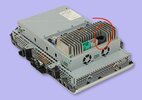Hi all. Just a informative / warning message from me

There is now a new, until now largely unknown, reason for getting a full black center screen on a first generation MCU1.0 found on cars up to and including 2015. This report does not cover the newer 1.5 MCU found in 2016 and newer cars, however a similar problem could occur in that system as well.
In the past weeks I have seen some cars where the EMMC was already replaced before (most by 3rd party, but also one that was replaced by Tesla).
The problem: the main screen went black again, and a error message pops up in the Instrument Cluster "center screen not functional". Exactly like you would see when the EMMC chip fails.
Some cars had been to Tesla Service Center already for this problem. At the Tesla Service Center they usually diagnosed it as "MCU needs to be completely replaced" and one customer was even told the problem was caused by "third party EMMC repair". Lucky for these customers they contacted me to find out what the problem was exactly.
The car owners all reported that the problems started with navigation issues, slow calculating routes, nav icon keeps spinning, new maps trying to download over wifi, etc. After scroll-wheel rebooting the MCU it stays black. Appearing almost exactly when EMMC chip is failing.
I have investigated these cases and they are all related to a failing navigation maps MicroSD card (this 16GB MicroSD card is located on the MCU1.0 mainboard). Apparently when the navigation card dies this can cause the entire system to crash and not even start anymore (not even when power cycling the mcu).
Even when the MicroSD card was completely removed or replaced the system would still not start and will still give a black screen. Huh!?
This was all on 2013-2015 MCU1.0 cars, newer MCU1.5 cars from 2016 and up have replaced the MicroSD card with a internal/soldered EMMC chip for the maps.
Anyway: a dead/corrupt MicroSD card can prevent the system from starting up completely. The Tegra computer will boot in what that is called "Recovery" mode and it will also write some changes to the boot environment stored on the NOR chip which is located on the Tegra module (this Spansion NOR chip contains the bootloader, environment and kernel images). This change prevents the Tegra from booting to normal mode. Wut?!
To fix this problem you will need to do several things:
1) Replace the MicroSD card with a new one (16GB recommended, but can be larger as well)
2) Fix the environment on the NOR chip on the Tegra module (mtd7 partition, swap boot bank, fix fail count)
3) Partition the new MicroSD card with the correct partitions (can use nav-sdcard-format.sh for that)
4) Install the correct navigation maps on the MicroSD card (EU maps are about 8GB in size)
Step 1 can be done easy by swapping the card in the MCU (accessible from the side of the MCU housing)
Step 2 is way more complex and only possible when you have full read/write access to the NOR chip. Most repair shops that deal with EMMC repairs will be able to do this.
Steps 3&4 can be done on a (Linux) pc if needed, but can also be done on the MCU itself (need root access for that).
If you go to Tesla with this problem they will most certainly tell you that "The entire MCU needs to be replaced", or even throw in a "Problem caused by 3rd party repair" excuse. All that for a cheap MicroSD card...
Considering these cars are getting older, the chances are increasing that more owners with MCU1.0 cars will eventually face a failing navigation MicroSD card.
Conclusion: If you see reports on black screens then it could be a navigation MicroSD issue. Even on cars that already had the EMMC chip replaced (by Tesla or by third party).
If you face any MCU1 related issues and don't want to go to Tesla feel free to PM me for help.




